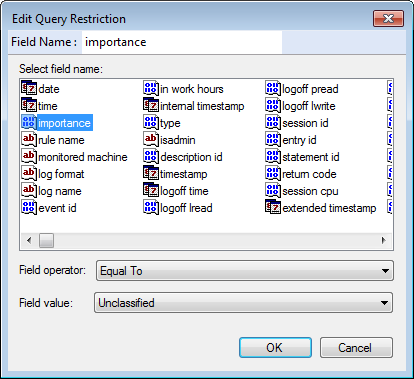Using the Edit Query Restriction dialog
To edit query restrictions for granular filtering and configuration:
1. The following table describes how to launch the Edit Query Restriction dialog for users, reports and processing rules:

Defining restrictions: Editing a query restriction
2. From the list of available fields, select a field. Optionally, key in the name in Field Name text box to search for the required field.
3. Specify a Field Operator for the selected field. Available operators include:
| Field Operator | Description |
|---|---|
| Equal To |
When the event field is equal to the value configured. |
| Less than |
When the event field is has a smaller value than the value configured. |
| Greater than |
When the event field is has a larger value than the value configured. |
| Occurred (Related to date/time fields) |
When the event field date occurred before the value date. |
| Like |
When the event field has similar text as the value text. |
| Contains |
When the event field contains the value text. |
| Value in List | When the event field is equal to one of the values in a list. |
4. Specify a Field Value for the selected field and operator. Some fields have predefined values; others require you to specify a value.
5. Click OK.
Note
Repeat steps 1 to 4 to add all the fields you want to include in the query.
Note
You can copy report restrictions from existing reports. From Reporting tab > Reports, right-click a report and select Copy Report Restrictions.

Defining restrictions: Customizing the condition
6. Once all the restrictions are defined, use the options described below to customize the query conditions:
| Options | Description |
|---|---|
| AND |
Select the condition to configure and select AND. The selected condition AND the following condition(s) must be met for the query to be valid. |
| OR |
Select the condition to configure and select OR. The selected condition OR the following condition(s) must be met for the query to be valid. |
| AND NOT |
Select the condition to configure and select AND NOT. This means that the selected condition has to match the restriction parameters but the following conditions must not. |
| OR NOT |
Select the condition to configure and select OR NOT. This means that the selected condition has to match the restriction parameters OR the following conditions must not. |
| + ( |
Click ‘+ (‘ to add an opening bracket to the selected condition. Conditions enclosed in brackets are processed first. |
| + ) |
Click ‘+ )’ to add a closing bracket to the selected condition. Conditions enclosed in brackets are processed first. |
| - ( |
Click ‘- (‘ to remove an opening bracket from the selected condition. |
| - ) |
Click ‘- )’ to remove a closing bracket from the selected condition. |
| Add |
Click Add to launch the restrictions dialog and add more fields to the condition. |
| Edit |
Click Edit to access the restrictions dialog and customize the selected condition. |
| Delete |
Click Delete to delete a condition. |
| Clear |
The Clear button deletes all the query conditions. |
| Up arrow |
Use the Up arrow key to move the selected condition up in the list. |
| Down arrow |
Use the Down arrow key to move the selected condition down in the list. |
7. Click Apply and OK.